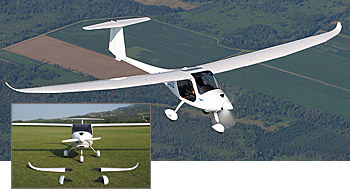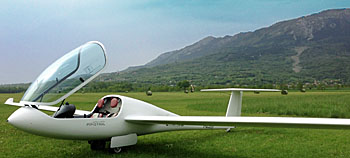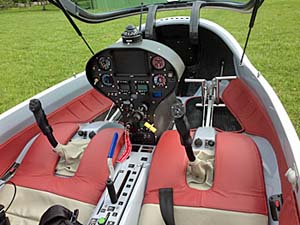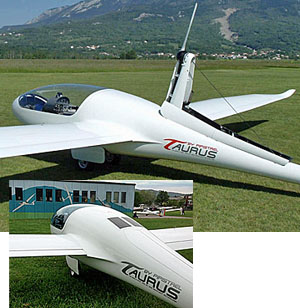
Pipistrel’s latest, the Sinus Flex, adds to their fleet of seven aircraft plus two trikes.

Mountains near Pipistrel’s factory prove handy to demonstrate Taurus’ significant soaring capability. Dual, retractable main gear give Taurus a solid stance on the ground.

Side-by-side seating in Taurus is not only unusual, it is very comfortable.

Now you see it; now you don’t. Taurus’ Rotax 503 engine and prop can disappear inside a fuselage cavity.
After Germany’s Aero 2013 event, we traveled to Pipistrel. It was our first visit to Slovenia, a country of four million with a section of the Alps running through it and a lovely route called the Emerald Trail to view the tall mountains. Slovenia proved a beautiful country that we’d love to visit again, but a leading reason to repeat is the presence of Pipistrel. This summer, the LSA and self-launched glider producer is in the news with their exchangeable wingtip Sinus Flex that transforms the long, shapely motorglider wings from a 50-foot span to a more hangar-manageable 40 feet. Using a single bolt, the change is said to take only five minutes and the unused tips can be stored in leather bags; the option price is $5,200. Buyers get both “a long range super-economic cruiser” and a “training aircraft,” noted Pipistrel. Sinus offers dual flight controls and a choice of either tailwheel or nosewheel gear, though the latter decision must be made at purchase.
When we visited my wife, Randee, and I were able to take a flight in Pipistrel’s Taurus. The unusual side-by-side self-launched sailplane is excellent for training. Since we are both soaring enthusiasts, going aloft near Pipistrel’s base to explore some light ridge lift gave an excellent chance to view the countryside surrounding the factory. We flew with Nejc Faganelj [Slovenian accent marks not shown]. “Nejc is pronounced ‘Nates’ and his surname is pronounced ‘Fug-a-nell’,” explained Taja Boscarol, who manages the company’s media and website among other duties. Nates proved to be a superb pilot despite his mid-20s youthfulness.
Taurus has a 49 foot wingspan with retractable main gear and a slick finish that allows it to reach a glide ratio of 41:1. That level of performance compares well to non-engined sailplanes with tandem seating, itself a noteworthy achievement. I’ve flown several sailplanes but never side-by-side and I am a new convert to this configuration; certainly, it is optimal for training or enjoying a flight with a companion. As Nates powered up to the nearby mountains, the engine noise was tolerable from the Rotax 503 but when he retracted engine and propeller into its fuselage locker, the remaining sound was air slipping around the cabin. We could converse at a whisper. When retract is commanded, the prop automatically aligns before completely hiding in the aft fuselage.
Nudging Taurus in close to the mountains, we shared the lift with a few paragliders and one other sailplane. For a longtime hang glider pilot like me this was pure delight. Taurus handles like many sailplanes, meaning you use rudder controls liberally. Yet the overall control feel seemed reasonably conventional and I adapted quickly. We found no thermals on the day of our flights and the ridge lift (air blowing up the mountain slope) was light. Taurus exploited the modest conditions to easily deliver a half hour of soaring before it was time to return to base. When we did, Nates had another surprise in store. As we approached at more than 100 knots, Nates converted this energy from a ground-skimming fly-by to pattern altitude in a graceful, banking arc that returned us to final for touchdown on the turf runway after extending the gear (watch video below). All the while, the Rotax and prop remained retracted as Nates expertly delivered us all the way back to Pipistrel’s hangar with the skill of someone who has done this a thousand times. Ground operation is far more straightforward than in many sailplanes thanks to the dual main gear (most sailplanes use a single main wheel with wingtip wheels or skids). Taurus offers a 78 knot (90 mph) cruise under power and consumes only 3.1 gallons an hour at 90 knots (104 mph). The motorglider is comfortable for cross country cruising but any soaring fan will find it excellent for thermaling or slope soaring. Not needing a tow aloft is very liberating. Pipistrel bought a number of Rotax 503s when Rotax stopped production; when these are finally used up, the company is ready with an electric option that is available today. Randee and I quickly regain our smiles when recalling our soaring adventure with Nates at Pipistrel in Slovenia.
Experience the low pass and precision taxi in this video (make sure your sound is on):


Leave a Reply